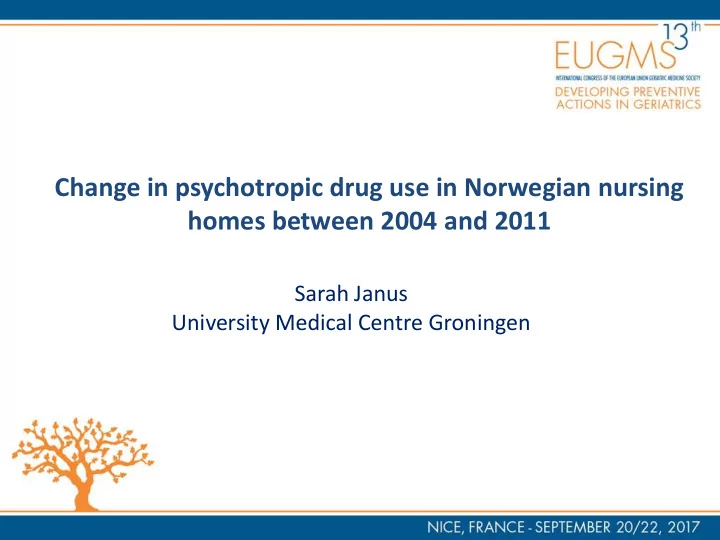

Change in psychotropic drug use in Norwegian nursing homes between 2004 and 2011 Sarah Janus University Medical Centre Groningen
CONFLICT OF INTEREST DISCLOSURE I have no potential conflict of interest to report.
Change in psychotropic drug use in Norwegian nursing homes between 2004 and 2011 G. Selbæk, PhD, S. Janus, PhD , S. Bergh, PhD, K. Engedal, PhD, S. Ruths, PhD, A. Helvik, PhD, J. Šaltytė Benth, PhD, S. Zuidema, PhD
Background • Since 2004 warnings by (inter) national drug agencies • 52%-75% of NH patients with dementia use at least one type of PDs • One previous Norwegian study (Ruths, 2013) – secondary data analysis of 6 cross-sectional studies, 1997 -2009
Research question • Has there been a change in the use of psychotropic drugs in Norwegian nursing homes between 2004 and 2011? • Did the predictors of use of specific psychotropic drug groups change?
Method Cross-sectional observational study of two Norwegian nursing home samples Participants • 2004 : 26 nursing homes from 18 municipalities (N=1163) • 2011 : 64 nursing homes from 55 municipalities (N=1858) Measures • Clinical Dementia Rating Scale (CDR ) • Neuropsychiatric Inventory (NPI ) • Physical Self-Maintenance scale (PSMS) • Psychotropic drugs: antipsychotics , antidepressants , anxiolytics , sedatives , anti-dementia drugs
Data analysis • For each outcome, a multivariate model containing fixed effects for dummy identifying two samples, 6 predictors (apathy, agitation, psychosis, affective sub-syndrome, CDR, PSMS) and interaction terms between the dummy and each predictor was fitted. • Akaike’s Information Criterion was applied to reduce the multivariate models. • The reduced multivariate models were adjusted for confounders.
Logistic regression model for hierarchical data with random effects for nursing home S1 (%) S2 (%) OR/RR (95% CI) p-value Drugs used <0.001 Antipsychotics 24 17 0.63 (0.49;0.82) 0.582 Antidepressants 38 36 0.94 (0.76;1.17) 0.645 Anxiolytics 24 22 0.93 (0.69;1.25) 0.707 Sedatives 29 30 1.06 (0.81;1.36) 1.24 (0.84;1.82) Anti-dementia drugs 11 15 0.281 0.97 (0.86;1.08) Psychotropic drugs 27 31 0.547
Multivariate models reduced by AIC (adjusted for confounders) Antipsychotics Predictors OR (95% CI) Time 2004 – 1 Ref 2011 0.66 (0.50; 0.88)* Apathy 1.01 (0.98; 1.04) Agitation 1.00 (0.99; 1.02) Psychosis 1.06 (1.04; 1.08)** Affective 1.04 (1.02; 1.06)** CDR 1.04 (1.01; 1.08)* PSMS Interactions Coefficient (SE) Code x Apathy Code x CDR Code x PSMS -0.043 (0.020)*
Anti-depressants Anxiolytics Anti-dementia Sedatives Total number drugs psychotropic drugs Predictors OR (95% CI) OR (95% CI) OR (95% CI) OR (95% CI) RR (95% CI) Time 2004 – 1 1 1 1 1 ref 2011 0.95 (0.76; 1.18) 0.91 (0.67; 1.23) 0.65 (0.31; 1.33) 1.10 (0.86; 1.43) 0.98 (0.89; 1.07) Apathy 1.02 (0.99; 1.04) 0.98 (0.96; 1.01) 1.41 (0.95; 2.10) 0.98 (0.95; 1.01) 1.00 (0.99; 1.01) Agitation 0.99 (0.98; 1.01) 1.02 (1.01; 1.03) 1.01 (0.99; 1.03) 1.01 (0.99; 1.02) 1.01 (1.00; 1.01)* Psychosis 0.99 (0.97; 1.01) 0.99 (0.98; 1.02) 1.03 (1.01; 1.05)* 0.98 (0.96; 1.00) 1.01 (1.00; 1.01)* Affective 1.09 (1.07; 1.11)** 1.08 (1.06; 1.10)** 1.02 (0.99; 1.04) 1.06 (1.04; 1.08)** 1.04 (1.03; 1.05)** CDR 0.99 (0.98; 1.02) 0.99 (0.96; 1.01) 0.93 (0.91; 0.95)** 0.998 (0.99; 1.01) PSMS 0.98 (0.97; 1.00) 0.98 (0.96; 1.00) 0.84 (0.82; 0.87) 1.00 (0.98; 1.02) 0.98 (0.97; 0.99)**
Discussion • Treatment recommendations against use of antipsychotic drugs • Previous studies reported that the reduction of antipsychotic drug use might have been counterbalanced. • No information about the use of non-pharmacological treatments + Studies adjusted for disease severity and neuropsychiatric symptoms + Wide variety of nursing homes form different regions and municipalities - Higher proportion of withdrawals of residents in 2010/2011
• Decrease in the prescription of antipsychotic drugs and no increase of any other psychotropic drug. • The widespread use of psychotropic medications highlights the importance of first trialing non- pharmacological treatment approaches.
Recommend
More recommend